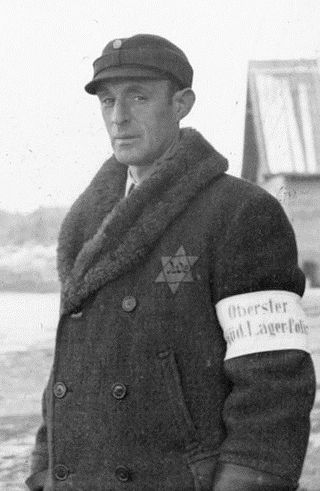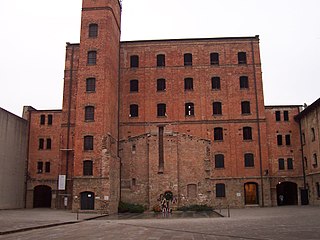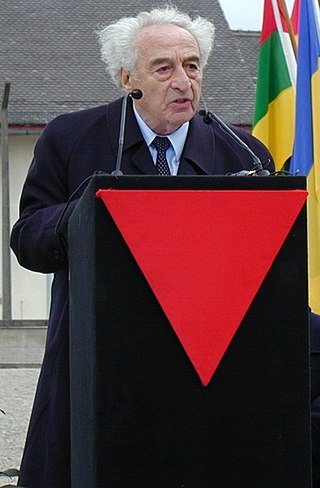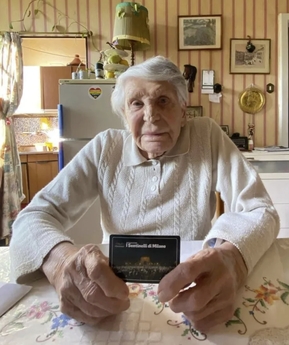External links
- Concentration Camp Dictionary (Retrieved March 27, 2011), by Oliver Lustig, Birkenau-Auschwitz and Dachau Holocaust Survivor
Language of Nazi concentration camps is a common stratum created in various languages of inmates of Nazi concentration camps that described the notions unique to life in the camps and served as lingua franca .
One part of the Nazi camp slang was German language terminology for people, things and events in the camps, where many ordinary German words acquired specific meanings and associations. Another was ad hoc slang based on the various native languages of inmates from different countries.

Buchenwald was a Nazi concentration camp established on Ettersberg hill near Weimar, Germany, in July 1937. It was one of the first and the largest of the concentration camps within Germany's 1937 borders. Many actual or suspected communists were among the first internees.

Mittelbau-Dora was a Nazi concentration camp located near Nordhausen in Thuringia, Germany. It was established in late summer 1943 as a subcamp of Buchenwald concentration camp, supplying slave labour from many Eastern countries occupied by Germany, for extending the nearby tunnels in the Kohnstein and for manufacturing the V-2 rocket and the V-1 flying bomb. In the summer of 1944, Mittelbau became an independent concentration camp with numerous subcamps of its own. In 1945, most of the surviving inmates were sent on death marches or crammed in trains of box-cars by the SS. On 11 April 1945, US troops freed the remaining prisoners.

Richard Baer was a German SS officer who, among other assignments, was the commandant of Auschwitz I concentration camp from May 1944 to January 1945, and right after, from February to April 1945, commandant of Mittelbau-Dora concentration camp. Following the war, Baer lived under an assumed name to avoid prosecution but was recognized and arrested in December 1960. He died in detention before he could stand trial.


LTI – Lingua Tertii Imperii: Notizbuch eines Philologen (1947) is a book by Victor Klemperer, Professor of Literature at the Dresden University of Technology. The title, half in Latin and half in German, translates to "The Language of the Third Reich: A Philologist's Notebook"; the book is published in English translation as The Language of the Third Reich.

Martin Gottfried Weiss, alternatively spelled Weiß, was the commandant of the Dachau concentration camp in 1945 at the time of his arrest. He also served from April 1940 until September 1942 as the commandant of Neuengamme concentration camp, and later, from November 1943 until May 1944, as the fourth commandant of Majdanek concentration camp. He was executed for war crimes.

A kapo or prisoner functionary was a prisoner in a Nazi camp who was assigned by the Schutzstaffel (SS) guards to supervise forced labor or carry out administrative tasks.

Riederloh was the name of two camps providing forced laborers to the gunpowder and ammunition facility of Dynamit AG (DAG) in Kaufbeuren, Bavaria. Located approximately 80 km to the southwest of Munich in Nazi Germany, the camps were named "Riederloh" and "Riederloh II" respectively.

Risiera di San Sabba is a five-storey brick-built compound located in Trieste, northern Italy, that functioned during World War II as a Nazi concentration camp for the detention and killing of political prisoners, and a transit camp for Jews, most of whom were then deported to Auschwitz. SS members Odilo Globočnik and Karl Frenzel, and Ivan Marchenko are all said to have participated in the killings at this camp. The cremation facilities, the only ones built inside a concentration camp in Italy, were installed by Erwin Lambert, and were destroyed before the camp was liberated. Today, the former concentration camp operates as a civic museum.

Bolzano was a transit camp operated by Nazi Germany in Bolzano from 1944 to 3 May 1945 during World War II. It was one of the largest Nazi Lager on Italian soil, along with those of Fossoli, Borgo San Dalmazzo and Trieste.

The Esterwegen concentration camp near Esterwegen was an early Nazi concentration camp within a series of camps first established in the Emsland district of Germany. It was established in the summer of 1933 as a concentration camp for 2000 so-called political Schutzhäftlinge and was for a time the second largest concentration camp after Dachau. The camp was closed in summer of 1936. Thereafter, until 1945 it was used as a prison camp. Political prisoners and so-called Nacht und Nebel prisoners were also held there. After the war ended, Esterwegen served as a British internment camp, as a prison, and, until 2000, as a depot for the German Army.

International concentration camp committees are organizations composed of former inmates of the various Nazi concentration camps, formed at various times, primarily after the Second World War. Although most survivors have since died and those who are still alive are generally octogenarians, the committees are still active.

Otto Förschner was a German Schutzstaffel (SS) officer and a Nazi concentration camp commander. After serving with the Waffen-SS on the Eastern Front, Förschner worked as a senior official at the Buchenwald concentration camp (1942-1943) and later served as the commandant of Mittelbau-Dora (1943-1945) and Kaufering (1945). Following the German defeat, he was convicted of war crimes by US occupation authorities at the Dachau trials and was hanged in May 1946.

During the Holocaust, death marches were massive forced transfers of prisoners from one Nazi camp to other locations, which involved walking long distances resulting in numerous deaths of weakened people. Most death marches took place toward the end of World War II, mostly after the summer/autumn of 1944. Hundreds of thousands of prisoners, mostly Jews, from Nazi camps near the Eastern Front were moved to camps inside Germany away from the Allied forces. Their purpose was to continue the use of prisoners' slave labour, to remove evidence of crimes against humanity, and to keep the prisoners from bargaining with the Allies.

Subcamps, officially Arbeitslager der Waffen-SS, were outlying detention centres (Haftstätten) that came under the command of a main concentration camps run by the SS in Nazi Germany and German-occupied Europe. The Nazis distinguished between the main camps and the subcamps subordinated to them. Survival conditions in the subcamps were, in many cases, poorer for the prisoners than those in the main camps.

Vinzenz Schöttl was a German Schutzstaffel (SS) officer and high-ranking functionary in the Nazi concentration camps.
Groupe Mémoire - Groep Herinnering (GM-GH) is a Belgian association set up in memory of the Belgian political prisoners of the Second World War.

Der Ort des Terrors. Geschichte der nationalsozialistischen Konzentrationslager is a nine-volume German encyclopedia series of Nazi Germany's camp system, published between 2005 and 2009 by Wolfgang Benz and Barbara Distel for C. H. Beck. It was edited by Angelika Königseder of the Zentrum für Antisemitismusforschung. The first volume deals with central issues concerning the Nazi camp system, volumes 2 to 7 contain articles on the main concentration camps and their subcamps in chronological order. Volume 8 deals with concentration and extermination camps in German-occupied Eastern Europe. Volume 9 also lists other types of camps in the Nazi forced labor camp system.

Lucy Salani was an Italian activist and the only known Italian transgender person to have survived the Nazi concentration camps. Born in Fossano and raised in Bologna, Salani was understood to be a gay man before undergoing gender-affirming surgery later in her life. An anti-fascist, Salani deserted both the fascist Italian and the Nazi German armies during World War II before being caught and deported to Dachau concentration camp in 1944, where she remained until the liberation of the camp by the United States Armed Forces in April 1945.